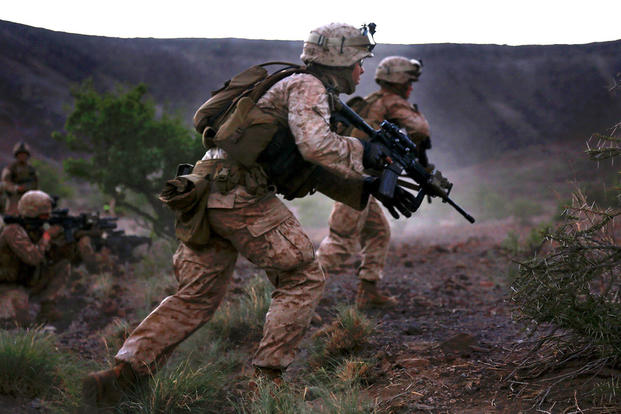The Marine Corps is asking defense firms to submit ideas for a new, lightweight body armor plate that can withstand two hits from non-armor piercing rounds.
"Marine Corps Systems Command will assess industry's capability to make a plate that would supplement the Enhanced Small Arms Protective Insert, or ESAPI, plates and provide sufficient protection for low-intensity threat environments," according to a press release announcing the Aug. 14 request for information (RFI).
Currently, Marines have the option of taking on "15 pounds to be protected or zero pounds and very little protection," Nick Pierce, Individual Armor team lead for Program Manager Infantry Combat Equipment (PM ICE), said in the release.
"This new lightweight plate would protect Marines and give commanders the choice of what plate to use based on the specific mission," he said.
If all goes well, initial fielding would likely go to combat units, Pierce said. Once market research is conducted, the contract could be awarded through full and open competition by the end of fiscal 2019, and fielding could take place as early as fiscal 2020, according to the release.
Marine officials called on industry to start working on lighter, more flexible body armor last fall.
Since then, PM ICE has conducted an analysis of more than 200 commercial plate designs from 38 companies to see what type of armor is possible, the release states.
Marine Corps Systems Command's Marine Expeditionary Rifle Squad Team tested a selection of the prototype plates through the Marine Corps Load Effects Assessment Program course and discovered that the lightweight hard armor plate will increase the mobility of Marines by 8 percent, according to the release.
"Without revealing too much information, I can state unequivocally that the new plates will significantly lighten the load from the Marine and increase their mobility," Pierce said. "This increased capability can save lives and win battles by enabling Marines to engage the enemy or move to cover and concealment more quickly."
Firms have until Sept. 7 to respond to the RFI and should be able to produce a minimum of 40,000 lightweight armor plates within a year of First Article Test approval, which is expected 180 days after contract award, the release states.
The new plates should be able to slide into the current plate carrier, as well as the new Plate Carrier, Gen III, which begins fielding in fiscal 2019. If a request for proposal is released, the plates will be purchased in standard sizes as well as three new PC Gen III sizes to assure Marines of every size and body type can use them, the release states.
"The decision to equip Marines with the lightweight plates would be a brilliant way to provide commanders the capability to make their unit more mobile and lethal, while exploiting the weakness of the enemy," said Capt. Ryan Moore, PM ICE project officer.
"If I can make a movement across open terrain to my next piece of cover or micro terrain 8 percent faster, I would argue that this lightened armor helps keep Marines much safer," he said.
-- Matthew Cox can be reached at matthew.cox@military.com.










